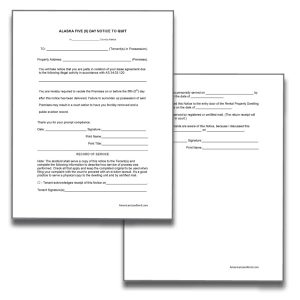Alaska Eviction Process
The following describes the process for evicting a tenant in Alaska known as a Forcible Entry and Detainer Action. This page applies to residential property (houses, apartments, etc.). It does not discuss evictions from commercial or agricultural property or from a mortgage foreclosure.
1. Notice to Quit is given to the tenant. Before a lawsuit to evict a tenant may be filed, the landlord must give the tenant written notice of the reason to terminate the tenancy. In some instances, the notice may give the tenant time to correct the problem (or move out) in order to avoid eviction.
2. Lawsuit is filed. The landlord files a Forcible Entry and Detainer complaint with the court if the tenant does not fix the problem or move by the deadline set in the Notice To Quit.
3. Tenant is given notice of the lawsuit. The tenant is served with a copy of the complaint and a court summons. The summons orders the tenant to:
a. appear at an eviction hearing, and
b. file a written answer to claims made in the complaint.
4. Eviction Hearing. The court holds an eviction hearing within 15 days after the case is filed in court and at least 2 days after the summons is served on the tenant. At this hearing, the judge will decide who gets possession of the property.
5. Judgment on Damages. If the complaint asks for damages, one of the following two things happens after the eviction hearing:
a. Damages Trial. This trial will only be held if, within 20 days after the complaint is served on the tenant, the tenant files an answer disagreeing with the claims for money damages made in the complaint.
b. Default Judgment. This will happen if the tenant fails to file an answer and the landlord requests a default judgment against the tenant for money.
Notice to Quit
A 24-Hour Notice to Quit is used when a tenant causes damage to a landlord’s property of $400 or more or if they have repeated the same violation that was previously served with a notice in the past 6 months. AS 34.03.120(a)(5)
-
Original price was: $12.95.$9.95Current price is: $9.95.
A 5 Day Notice to Quit is used when a tenant engages in illegal activity on the premises such as prostitution, gambling, illicit drug use, etc. AS 34.03.220(2)
-
Original price was: $12.95.$9.95Current price is: $9.95.
A 7 Day Notice to Pay or Quit is used solely for the nonpayment of rent. AS 34.03.220(b)
-
Original price was: $12.95.$9.95Current price is: $9.95.
A 10 Day Notice to Cure or Quit is intended to for tenancy violations other than the nonpayment of rent such as unauthorized pets or refusing a landlord access to the property after notice is given, see Alaska Notice of Entry. AS 34.03.220(b)
-
Original price was: $12.95.$9.95Current price is: $9.95.
More Alaska Eviction Information
The following legal references are available at public libraries and clerk of the court offices as well as the court system’s website: www.courts.alaska.gov
Alaska Statutes
- AS 09.45.060 – .160 describe eviction procedure.
- AS 34.03.010 – .390 is the “Uniform Residential Landlord And
Tenant Act” which establishes the rights and duties of landlords
and tenants.
Alaska Rules of Court
- Civil Rule 85 describes eviction procedure
- Civil Rules 3, 4, 5, 6, 45, 55, 76, and others (general rules
governing procedures in civil cases).


